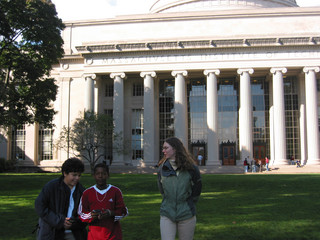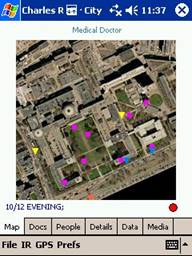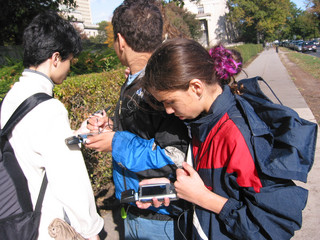Charles River City
 Charles River City, loosely based on Chris Dede's MUVE "River City", is MIT's second generation outdoor GPS-based Augmented Reality game. While the game itself introduces some key new game play and learning elements, it is also built on a dynamic engine that will allow others to build similar games using an authoring tool that should be released in the coming months. Charles River City, loosely based on Chris Dede's MUVE "River City", is MIT's second generation outdoor GPS-based Augmented Reality game. While the game itself introduces some key new game play and learning elements, it is also built on a dynamic engine that will allow others to build similar games using an authoring tool that should be released in the coming months.
The basic scenario for Charles River City is that there has been an outbreak of illness coinciding with a major event in the Boston Metro Area. The event changes for each run of the game, so that it is based on something timely. One of the first runs started out like this:
- The July 1st, 2004 headline of the Boston Globe reads “26 More Fall to Mysterious Illness as DNC Looms”. A rash of disease has swept through Boston; and—with the Democratic National Convention coming to the city in a few weeks—citizens, politicians and health officials are all concerned. What is the source of the illness? Is this an act of bioterrorism or a naturally occurring event?
 Players are then told that a team of 20 experts is brought in to investigate the problem, including epidemiologists, physicians, public health experts, laboratory scientists, biologists, computer scientists, and environmental specialists. This group must work together first to evaluate case reports and available surveillance data, then to plan and implement rapidly an investigation to determine the cause and source of the outbreak, assess risk, communicate with the professional and public communities and identify effective interventions. The team will compile information through collection and analysis of environmental samples, hospital records, patient histories, clinical samples, and testimony from community members, then engage in collaborative analysis and interpretation. The team must determine its findings and propose actions very quickly in order to assess the risk, propose timely means to reduce risk and treat affected persons, diminish societal fears, and work with decision makers to design and implement a solution to the problem. Players are then told that a team of 20 experts is brought in to investigate the problem, including epidemiologists, physicians, public health experts, laboratory scientists, biologists, computer scientists, and environmental specialists. This group must work together first to evaluate case reports and available surveillance data, then to plan and implement rapidly an investigation to determine the cause and source of the outbreak, assess risk, communicate with the professional and public communities and identify effective interventions. The team will compile information through collection and analysis of environmental samples, hospital records, patient histories, clinical samples, and testimony from community members, then engage in collaborative analysis and interpretation. The team must determine its findings and propose actions very quickly in order to assess the risk, propose timely means to reduce risk and treat affected persons, diminish societal fears, and work with decision makers to design and implement a solution to the problem.
 While much of the game play is similar to Environmental Detectives (and in fact all of the capabilities of the Environmental Detectives game is also built into the newer engine) including location sensing, interviewing, and data collection, the new game offers several features that make it a more interesting and dynamic environment. These features include: While much of the game play is similar to Environmental Detectives (and in fact all of the capabilities of the Environmental Detectives game is also built into the newer engine) including location sensing, interviewing, and data collection, the new game offers several features that make it a more interesting and dynamic environment. These features include:
- Time dependence – The game can now change over time. Non-player characters (NPCs) can change what they say, appear or disappear, and change location based on the time in the game. Similarly, samples can change over time representing the dissipation of a chemical, or some biological change.
- Distinct player roles – Players take on one of several distinct roles in the game. These roles provide the players with special capabilities (e.g. being able to take certain kinds of samples, or receive unique information). The role also dictates what information players get from the NPCs (e.g. someone might say one thing to a police officer and something entirely different to the medical doctor).
- Individual medical symptoms – Individuals in the game can present with medical symptoms that are accessible by some range of the real players. These can also change over time to represent the progression or spread of a disease.
- Increased role of data beaming – Players can beam data that they collect to other players within the game. This information might be interviews that they have collected from disparate places or differing roles, or it may be field data that they have collected.
- Cascading events – Events can cause the triggering of other events. For example, speaking to one NPC might cause another NPC to appear somewhere else on the map (i.e. an NPC tells you about someone else with who you should speak). The triggering event may be something that a player experiences directly or come from information beamed to them by another player.
- Greater stability and usability – Improved GPS readings, application stability and organization of information make the game more flexible and useful
To see an overview of the technical aspects of the latest outdoor games take a look at the Technical Overview Presentation (in Flash).

|
 Players are then told that a team of 20 experts is brought in to investigate the problem, including epidemiologists, physicians, public health experts, laboratory scientists, biologists, computer scientists, and environmental specialists. This group must work together first to evaluate case reports and available surveillance data, then to plan and implement rapidly an investigation to determine the cause and source of the outbreak, assess risk, communicate with the professional and public communities and identify effective interventions. The team will compile information through collection and analysis of environmental samples, hospital records, patient histories, clinical samples, and testimony from community members, then engage in collaborative analysis and interpretation. The team must determine its findings and propose actions very quickly in order to assess the risk, propose timely means to reduce risk and treat affected persons, diminish societal fears, and work with decision makers to design and implement a solution to the problem.
Players are then told that a team of 20 experts is brought in to investigate the problem, including epidemiologists, physicians, public health experts, laboratory scientists, biologists, computer scientists, and environmental specialists. This group must work together first to evaluate case reports and available surveillance data, then to plan and implement rapidly an investigation to determine the cause and source of the outbreak, assess risk, communicate with the professional and public communities and identify effective interventions. The team will compile information through collection and analysis of environmental samples, hospital records, patient histories, clinical samples, and testimony from community members, then engage in collaborative analysis and interpretation. The team must determine its findings and propose actions very quickly in order to assess the risk, propose timely means to reduce risk and treat affected persons, diminish societal fears, and work with decision makers to design and implement a solution to the problem.